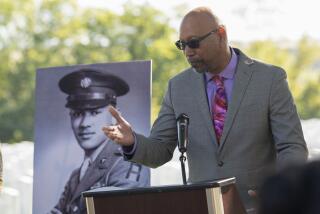WWI Veteran, 99, Takes a Look Back
- Share via
As Paul Jarrett, 99, recounted his World War I experiences, his voice was strong and his spirit bright. The memories were clear in his mind, as though the events had happened yesterday.
“About a month after war was declared, in April, 1917, I knew I would be drafted, so I enlisted,” said Jarrett, who was then 21 and running a stockyard in Osceola, Neb.
When he joined the service, Jarrett said, “(I) went to an officer I knew with the National Guard, and he told me he’d like to send me to officer’s training school for a three-month class.”
He left the school at Fort Snelling, Minn., a second lieutenant and was sent home for two weeks. Then, he found himself on a train bound for Camp Mills on New York’s Long Island, where he became part of the 42nd Infantry Division, later known as the Rainbow Division.
“We became the Rainbow because troops had to be sent quickly to France and the elite National Guard was called in from 26 different states,” Jarrett said. “Someone said, ‘It’s like a rainbow.’ ”
Jarrett, who now lives in Woodland Hills, recently marked his 99th birthday with a celebration at his daughter’s home. He will be one of the few World War I veterans to attend a reunion of the 42nd Infantry Division July 14 in Louisville, Ky. The division also served in World War II.
“I was the first man of our regiment to set foot on French soil when we landed at Brest, France, in November, 1917,” Jarrett recalled. “For some reason, I was picked for everything, and I was sent to a hand-to-hand combat school in the north of France near Belgium, where I learned trench, knife and bayonet fighting.”
By Christmas Eve, 1917, Jarrett was in the trenches on the front lines. He fought in the Battle of Champagne in July, 1918, and said he often had to crawl all night to capture prisoners.
Once, when he and his men had nothing to eat, they found some bread, ate it and landed in the hospital, thinking they were poisoned.
“We learned the bread had absorbed phosgene gas,” he said.
On July 29, 1918, an artillery shell blew him over an embankment, and he broke his knee.
“I wanted to go back, and even though the doctor told me I couldn’t be in combat with my leg, I did get back to my company,” he said. Later, he received the Purple Heart.
He remained in the hospital until May, 1919, in France and returned to the United States as a hospital patient until August of that year.
As an officer, Jarrett carried a .45-caliber gun and a dagger. “When I came home, I threw my .45 in the river,” he said.
After the war, Jarrett went to the University of Omaha on the GI bill, but because the cold weather bothered him, he moved to Los Angeles on Thanksgiving Day, 1921.
Then he sold real estate for Harry Culver (Culver City was named after him), worked for Southern Pacific Railroad and owned a lumber company.
In 1926, he became Culver City’s city clerk and served as postmaster there from 1939 until his retirement in 1958.
“I didn’t want to retire, so I went to work at MGM Studios for five years as a prop maker and in special effects,” Jarrett said.
Never one to be idle, Jarrett has traveled widely and has returned to France twice to the scene of the long-ago World War I battles. On July 16, 1989, the citizens of Neuviller, France, surprised him when they named a street there “Rue Paul J. Jarrett.”
“The French people really appreciated what we did for them in WWI,” he said.
“In WWI, we had no choice,” Jarrett added, “but I think throughout all the human race, wars are just stupidity. You can’t solve anything that way.”
More to Read
Go beyond the scoreboard
Get the latest on L.A.'s teams in the daily Sports Report newsletter.
You may occasionally receive promotional content from the Los Angeles Times.









